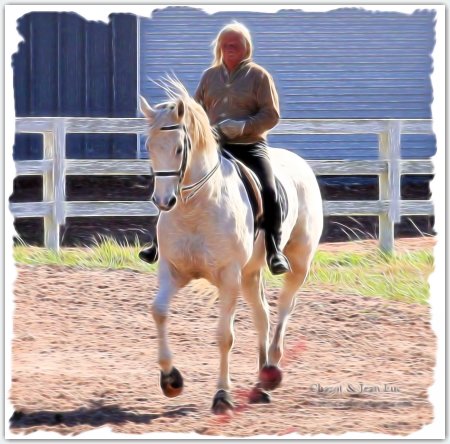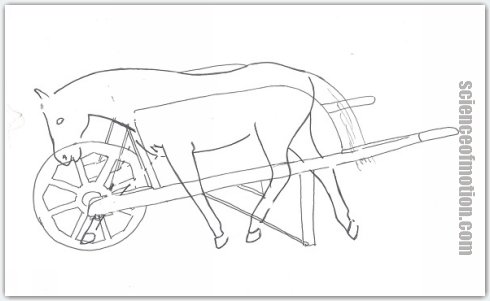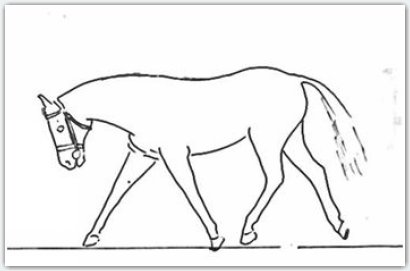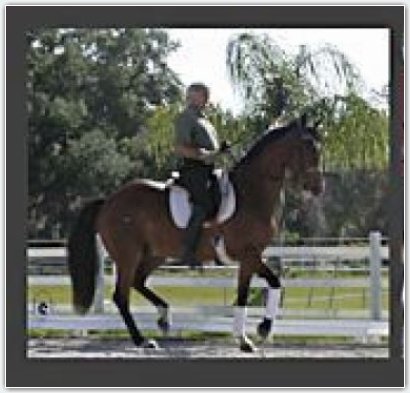Mechanoresposiveness 19
Mechanoresponsiveness 19
The wheelbarrow syndrome
Jean Luc Cornille

This silhouette, which is the computer silhouette of a real picture, is average of most training techniques, long and low, deep, round, driving aids, etc. Just add a wheel, two handlers and you have a wheelbarrow. Whatever the specialty, dressage, hunter jumper, western pleasure, trial riding, the average downward inclination of the horses’ body is about the angle of a wheelbarrow.
I was told, like everybody else, about stretching, swinging and relaxation, but I also learned as a young gymnast how painful a performance can be when our physique is not properly developed and coordinated for the move. Having worked with a bad coach and then a good coach, I learned that bad trainers want you to fit their system. You know the stereotypes, “My way or the high way – Because I am the trainer, that’s why, etc.” Instead, good trainers respect and adapt their approach to the athletes’ morphology and style.
I asked pertinent questions, but did not received pertinent responses. I was told to believe what I was told because the authority of the teacher, because this is the way it has always been done, because such is the system, because the prestige of the school. I wanted to know how the horse does it and I was told how to make the horse do it. The “prestige of the school” was often used as an umbrella against progress. The saying of the Cadre Noir de Saumur is, “Respect for tradition should not exclude the love of progress.” (Colonel Danloux) The father of modern equitation, François Robichon de la Gueriniere wrote, “And also conserves the ease, balance and grace that are the properties of a good horseman and the result of an extensive progressive study of the science”. (Ecole de cavalerie, 1731) Classic is not repeating the same theories even when contradicted by new knowledge. Classic is furthering the wisdom of our ancestors in the light of new knowledge.
Ease and elegance are the outcome of a body coordination preparing efficiently the horse physique for the athletic demand of the performance. Our ancestors had elementary knowledge of equine biomechanics. Old masters touched the horse’s limbs with a whip because they were not aware that doing so, they were handicapping the cycle of storage and reuse of elastic strain energy that is the fundamental principle of locomotion and performances. Our ancestors were not aware that altering proper synchronization between flexion, extension and rotation of the joints created friction and consequent arthritis in the joints. La Gueriniere talked about “Perfecting nature with the aid of the art”. The knowledge of the horse nature has considerably evolved and cannot be perfected without extensive study of science.
The wheelbarrow syndrome talks about stretching of the upper neck muscles, but structure and function of the upper neck muscles contradict the theory. The splenius and the semispinalis capitis cover the entire length of the neck and are designed to resist gravity with the help of the nuchal ligament. Considering that the neck and head weight about 10% of the horse body weight, the splenius and the semispinalis capitis resist 100pounds or more, pulled down to earth by the attraction of gravity. The purpose of the nuchal ligament is easing the work of the upper neck muscles by supporting part of the load and this is why horse lowers the neck after work. However, the muscles still resist attraction of gravity; they don’t stretch.
I was told, like everybody else, that back muscles stretch, relax, that the thoracolumbar spine swings, that greater amplitude of movement can be achieves increasing the amplitude of the thoracolumbar spine movements. Since Richart Tucker’s first dynamic analysis of the equine back, that was made in 1964, these theories are contradicted by every serious studies furthering knowledge and understanding of the equine vertebral column mechanism. In 1976, Hans Carlson demonstrated that the main function of the back muscles was, protecting the thoracolumbar spine from an amplitude of movement that would exceed its possible range of motion. Leo Jeffcott measured in 1980, the possible range of motion of the equine thoracolumbar spine and found that, under the conditions of his experiment, the possible range of movement of the entire thoracolumbar spine was only 53,1mm which is less than 2,1/4 inches in the dorso-ventral direction. The main function of the back muscles is resisting, reducing, redirecting, modulating forces induced on the thoracolumbar spine by limbs actions, gravity, inertia, rider movements other forces. Back muscles create movements, compensate for contractions, stabilize the spine, through subtle nuances in muscle tone.
Most researchers are not riders. Their aim is not proving or disproving equestrian theories. Their research is about further understanding how the horse’s physique effectively works. However, when advanced knowledge of equine biomechanics takes a different direction than the one traditionally promoted, many protect traditional view rejecting scientific progress. Our ancestors explained their finding through metaphors and paraphrases because they did not have the knowledge of how the horse’s physique effectively functions. Horses do not function through metaphors; they function through laws of physics and dynamics that were previously unknown but are now well explained. When laws of physics contradict familiar metaphors, many rather believe in the parables instead of the informed and factual documentation. Assumption is the first step of serious research, but only the first step, a hypothesis, that has to be verified. The search for true is the factual documentation of search hypothesis. Theories based on assumptions rather skip the real research because the real research might expose the inaccuracy of the hypothesis.
In their research on human knee osteoarthritis, Craig Walker, David Hayesm John E. Block and Nicholas J. London explain that almost all therapies have focused on pharmacotherapy and direct chondral repair. Much greater results can be achieved concentrating on aberrant biomechanics that are stressing the subchondral bone. It is now widely accepted that arthritis commences with microcracks and microfractures in the subchondral bone before altering the cartilages. The title of the study taken in reference is, “Unload it’”. While millions of dollars are invested in drugs, the greatest remedy for human knee arthritis, is, losing weight. Even if the pharmaceutic industry sponsored the study, they will keep the results quiet and keep selling drugs. The equestrian world reacts exactly the same way. Even if every serious studies expose the damaging effects of loading the forelegs, arthritis in the knees, fetlock, navicular, the equestrian industry keeps promoting lowering the neck, deep work, driving aids and injecting the joints to ease the damages.
I have been told, like everybody else, that proper training was lowering the neck first and then raising the head and neck, usually with half halt, for balance.  How a horse can evolve from this imbalance on the forehand, to this balance where the thrust generated by the hind legs allows lift of the front end and self-carriage, was never clearly explained. There were and there are numerous statements and theories but never any credible explanation. The general consensus is that balance is achieved shifting the weight back over the haunches. In her 2002 PhD thesis, Sophie Biau commented on the weight transfer concept writing, “These notions that are still in use, have no scientific meaning form the biomechanical perspective.”
How a horse can evolve from this imbalance on the forehand, to this balance where the thrust generated by the hind legs allows lift of the front end and self-carriage, was never clearly explained. There were and there are numerous statements and theories but never any credible explanation. The general consensus is that balance is achieved shifting the weight back over the haunches. In her 2002 PhD thesis, Sophie Biau commented on the weight transfer concept writing, “These notions that are still in use, have no scientific meaning form the biomechanical perspective.”
The hind legs don’t carry more weight when the horse is collected or in balance. They increase the duration of the decelerating phase resisting forward shift of the weight over the forelegs and increasing the storage of elastic strain energy in order to deal with the addition of the rider’s weight. From impact to almost half way through the stride, the alighting hind leg decelerates the horse’s body storing in the tendons, aponeurosis, ligaments and muscles an elastic strain energy that is used for the propulsive phase and the swing. The propulsive phase commences after the peak vertical, which is the moment where the hind leg acts vertically on the ground. The hind limb is at this time moving backward. The net effect of the hind leg’s propulsive force is therefore a force in the direction of the motion. The thrust generated by the hind legs is delivered to the thoracolumbar spine through the sacroiliac attachment. The thrust is then transmitted forward from one vertebra to the next where it is submitted to the attraction of gravity. Back muscles coordinate their action converting part of the hind leg’s initial thrust into upward forces. “An initial thrust on the column is translated into a series of predominantly vertical and horizontal forces which diminish progressively as they pass from one vertebrae to the next”. (Richard Tucker, Contribution to the Biomechanics of the vertebral Column, Acta Thoeriologica, VOL. IX, 13: 171-192, BIALOWIEZA, 30. XL. 1964).
With further understanding of the equine vertebral column mechanism, the management by the thoracolumbar spine of the thrust generated by the hind legs is more complex and in fact differs from Richard Tucker’s explanation, but the fundamental concept remains accurate. Back muscles manage forces and have the capacity to convert the thrust generated by the hind legs into upward forces. This is how balance control is mastered. It is a phenomenon occurring from the hind legs forward through the thoracolumbar spine. It is not a backward shift of the weight over the haunches.
Without proper work of the back muscles, a percentage of the thrust generated by the hind leg loads the forelegs hampering the forelegs capacity to propel the horse’s body upward. In normal locomotion, the forelegs produce greater upward propulsive force than the hind legs. “In horses, and most other mammalian quadrupeds, 57% of the vertical impulse is applied through the thoracic limbs, and only 43% through the hind limbs.” (H. W. Merkens, H. C. Schamhardt,G. J. van Osch, A. J. van den Bogert, 1993). At the contrary, when the back muscles properly manage the thrust generated by the hind legs between horizontal forces and vertical forces, the load on the forelegs remains within the upward propulsive capacity of the forelegs and the forelegs can do what they are designed to do, which is propelling the body upward.
There is no room in the mechanism of the equine back for stretching and relaxation. The horse, as we know it today, is not the horse that our ancestors theorized based on superficial observation and feeling. They were amazingly clever considering the paucity of available scientific knowledge. Classic authors would not understand why, having the privilege of applying new knowledge, anyone would keep applying antiquated theories under the name of tradition.


 twitter
twitter facebook
facebook stumbleupon
stumbleupon pinterest
pinterest linkedin
linkedin